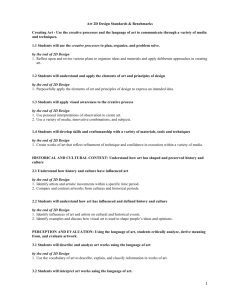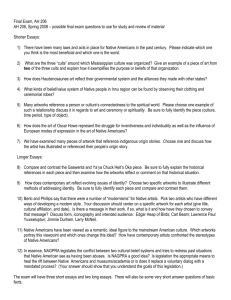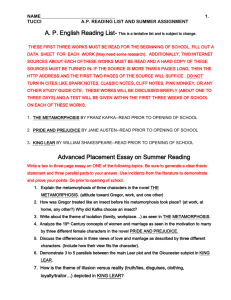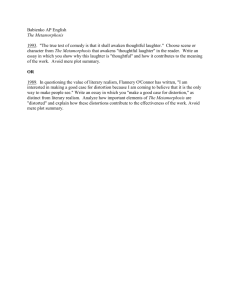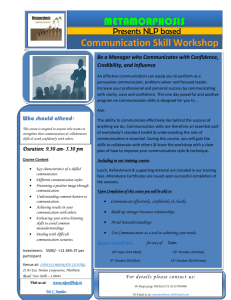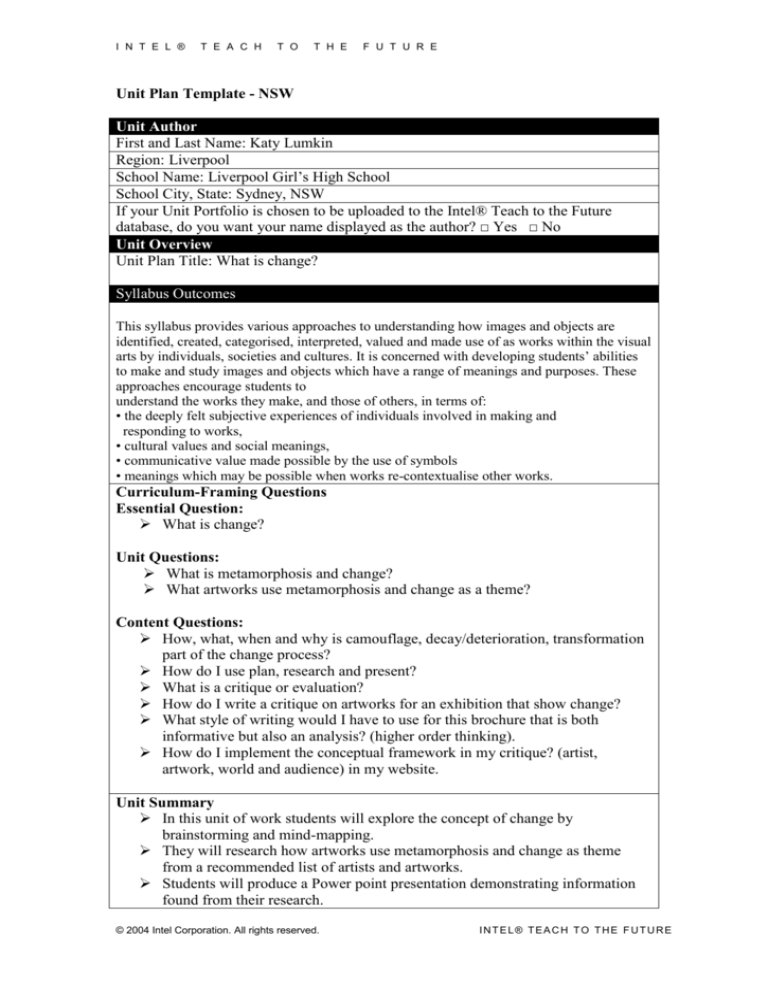
I N T E L ®
T E A C H
T O
T H E
F U T U R E
Unit Plan Template - NSW
Unit Author
First and Last Name: Katy Lumkin
Region: Liverpool
School Name: Liverpool Girl’s High School
School City, State: Sydney, NSW
If your Unit Portfolio is chosen to be uploaded to the Intel® Teach to the Future
database, do you want your name displayed as the author? □ Yes □ No
Unit Overview
Unit Plan Title: What is change?
Syllabus Outcomes
This syllabus provides various approaches to understanding how images and objects are
identified, created, categorised, interpreted, valued and made use of as works within the visual
arts by individuals, societies and cultures. It is concerned with developing students’ abilities
to make and study images and objects which have a range of meanings and purposes. These
approaches encourage students to
understand the works they make, and those of others, in terms of:
• the deeply felt subjective experiences of individuals involved in making and
responding to works,
• cultural values and social meanings,
• communicative value made possible by the use of symbols
• meanings which may be possible when works re-contextualise other works.
Curriculum-Framing Questions
Essential Question:
What is change?
Unit Questions:
What is metamorphosis and change?
What artworks use metamorphosis and change as a theme?
Content Questions:
How, what, when and why is camouflage, decay/deterioration, transformation
part of the change process?
How do I use plan, research and present?
What is a critique or evaluation?
How do I write a critique on artworks for an exhibition that show change?
What style of writing would I have to use for this brochure that is both
informative but also an analysis? (higher order thinking).
How do I implement the conceptual framework in my critique? (artist,
artwork, world and audience) in my website.
Unit Summary
In this unit of work students will explore the concept of change by
brainstorming and mind-mapping.
They will research how artworks use metamorphosis and change as theme
from a recommended list of artists and artworks.
Students will produce a Power point presentation demonstrating information
found from their research.
© 2004 Intel Corporation. All rights reserved.
INTEL® TEACH TO THE FUTURE
I N T E L ®
T E A C H
T O
T H E
F U T U R E
Students will then further develop this into a critique on artworks for an
exhibition on “Metamorphosis and Change” at a gallery in the form of a
brochure.
Students will research and provide a case-study on three artists and their
artworks and create a website called “Framing the Artist” detailing art practice
and a brief biography of the chosen artists.
They will observe, discuss, analyse, and make critical judgments about artistic
works.
Teaching and Learning Strategies
Bloom’s Taxonomy/Group Work
Group Work
Professional Learning
Need more professional learning on designing rubrics specific to tasks.
Year Level(s)
Year 9 Visual Arts
Special needs such as: Gifted, ESL
Extension work for Gifted students in the form of investigation and research. ESL
students will benefit by practising organisation of information and publishing the
written word. Students with high needs will need structure and guided instructions
when using programs such as Publisher and Power point. Smaller groups will need to
be organised when going through these programs.
Key Learning/Subject Areas
Creative Arts/Visual Arts
Procedures:
Brainstorming and mind-mapping on what is change.
From a given list of artists and artworks students compile resources for from
the web, Encarta and reference books
Compile resources from each program (Power Point/Publisher) eg. Sounds,
animated gifs, images.
Use storyboard design templates for compiling and sequencing slides for both
Power Point and Web Site presentations.
Use Power Point presentation to show students how to use the programs
Teacher demonstrations to small groups and whole class on the use of
programs.
Evaluations and reflections from students and teacher.
Approximate time needed:
10 weeks duration (10 x 70 minutes lessons)
Prerequisite Skills:
Conceptual Framework- artist/artwork/world/audience
Frames: subjective, cultural, structural, post-modern
Evaluations and Critiques
Materials and Resources
Technology - Hardware
© 2004 Intel Corporation. All rights reserved.
INTEL® TEACH TO THE FUTURE
I N T E L ®
T E A C H
T O
T H E
F U T U R E
Camera
Printer
Video Camera
Computer(s)
Datashow Projector
Digital camera
Scanner
DVD player
Television/Averkey
Internet connection
Technology - Software
CD-ROMs
Database/spreadsheet
Internet Web Browser
Word processing
Desktop Publishing
Multimedia
email software
Animation software
Printed Materials: textbooks, story books, manuals, reference materials etc.
Supplies: Things that have to be ordered or gathered to implement your Unit
Internet Resources:
Works Cited Template – MLA Format
Swinglehurst, Edmund The Art of the Surrealists Sydney Australia: The Book Company 1995.
Craig, Diana. The Life and Works of Archimboldo Great Britain: Paragon Book Service Limited 1996.
Harris, Nathaniel The Life and Works of Dali Book Service Limited 1994.
Chees, Broos, Slade et al. In the Picture- Framing the Visual Arts Australia: Oxford University Press 1996.
M.C. Escher – Works of Art London: Leopard Books – Random House 1994.
“Monarch Butterfly Metamorphosis.” Metamorphosis. Microsoft Encarta Encyclopedia Deluxe 2001.
Works Cited
Escher’s Metamorphosis. < www.insite.com.br/rodrigo/images/ escher/metamorphosis.html >.
Biography of M.C. Escher <http://www.mcescher.com/Biography/biography.html>.
Dali Prints 8. < http://a-prints.com/d/dali8.shtml>.
Archimboldo - Like Vegetable Faces <http://www.ashland.com/education/lesson_plans/week37.html>.
Others: Excursion to the Australian Museum/ Taronga Zoo/Art Gallery of NSW
Accommodations for Differentiated Learning
Students with Special Needs: modified requirements, differentiated instruction and
assessment, extended work time, guiding templates, support structures, and personnel.
English as a Second Language (ESL) Student: Appropriate resources including
Internet sites; a variety of ways available to demonstrate their learning, support
personnel, help of peers
Gifted Student: more challenging tasks, extended investigation in related topics of
the learner’s choice, open-ended tasks or projects that allow for deeper analysis and
evaluation of issues.
Student Assessment:
Refer to Rubrics and Self-Reflection Sheets designed for Power Point/ Web/Brochure
Key Word Search:
change, camouflage, metamorphosis, simulated textures, photomontage,
grotesque, chaos, incongruous, symbol, Surrealism
© 2004 Intel Corporation. All rights reserved.
INTEL® TEACH TO THE FUTURE
I N T E L ®
T E A C H
T O
T H E
F U T U R E
© Copyright NSW Department of Education and Training 2003.
© 2004 Intel Corporation. All rights reserved.
INTEL® TEACH TO THE FUTURE


